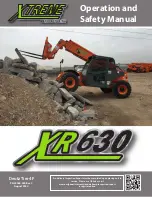
Form No. 20027 • G6-42P Owner/Operator Manual
The following information assumes the handler cannot be moved under
its own power
.
Before moving the handler, read all of the following information to understand
options available. Then select the appropriate method.
The ability to steer the handler increases the safety of moving the unit in some
situations. The steering system permits manual steering if engine or power
assist feature fails.
Remember:
• Manual steering may be possible without power assist,
steering will be
slow and will require much greater force.
• Response to manual steering will be increased if parking brake is released
and front axle drive is bypassed, permitting front wheels to roll.
MOVING SHORT DISTANCES
If it is only necessary to move handler a short distance (less than 100 feet), it
is permissible to use a vehicle of sufficient capacity to tow the unit with no
previous preparation. Drive wheels will not roll. If the unit must be moved
more than 100 feet (but less than 200 yards), it is permissible to use a vehicle
of sufficient capacity to tow unit after you:
• Activate “Tow Bypass”.
See Below
• Release parking brake.
See Page 20.1
MOVING LONGER DISTANCES
If the handler must be moved more than 200 yards, it must be loaded on to
a trailer of sufficient capacity.
TO ACTIVATE TOW BYPASS
Figure 20-1
1. Hold large hex to prevent movement and loosen reverse relief valve cartridge
(small hex) two full turns.
2. Repeat step 1 for forward relief valve. Front axle drive is now bypassed.
3. Before returning machine to service, be certain to
return relief valve
cartridges to original position.
MOVING HANDLER IN EMERGENCY
20.0
WARNING
!
Towing handler with all wheels on
ground for more than 200 yards
could cause serious damage to
hydraulic drive components.
NOTE!
Forward relief valve is located
on bottom of pump case directly
below reverse relief valve.
LARGE HEX
REVERSE RELIEF
VALVE
SMALL
HEX




























